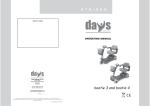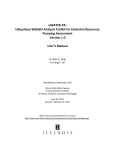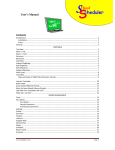Download Open Bike Initiative Guide Book - Westside Transportation Alliance
Transcript
Open Bike Initiative Bike Share Guidebook Created by: Westside Transportation Alliance December 2013 Acknowledgements The OBI Bike Share Guidebook is the result of efforts made by the Westside Transportation Alliance and the Open Bike Initiative to distill Intel’s bike share pilot project into an easily implementable program for Washington County employers. Open Bike Initiative project partners include: Intel, Community Cycling Center, Nike, Bicycle Transportation Alliance, Oregon Transportation Research Education Consortium (OTREC) and Westside Transportation Alliance. Table of Contents Introduction 4 Why Bike Share? 4 Timeline 5 Staff Preparation 6 Organization Preparation 7 Employee Preparation 8 Site Preparation 9 System Preparation 10 Launch 11 Operations 12 Next Steps 13 Conclusion 13 Westside Transportation Alliance 3 Introduction Employees at Intel’s Hillsboro, Oregon campuses developed the Open Bike Initiative (OBI) in part as a way to address transportation challenges common to many organizations: limited options for completing the ‘last mile’ between public transit and the campus, lack of alternative transportation options, inadequate connectivity between multiple sites spread out over a large area, and barriers to entering the bike share market as a consumer. OBI 1.0 is a do-it-yourself bike share program that is scalable, adaptable and achievable, making it a perfect model for other employers. There will be a later OBI 2.0 system that is more high-tech, resulting in greater data and features, but will be more expensive as well. OBI 1.0 is a program in which users text the bike share phone number to receive a code to unlock the the bike lock. OBI developed a holistic process of organizational, physical, technical and participant preparations, which has enabled smoother implementation and an adaptive program. This document is intended as a guide for implementing a similar low-cost bike share program. Greater detail, technical documents and future updates can be found at openbikeinitiative.org. Questions can be directed to the Westside Transportation Alliance. Why Bike Share? Bike share has many benefits for employees, employers and the region at large. For employees, bike share presents more transportation options and flexibility. They now have an alternative for getting to meetings, going to lunch, dealing with the last mile connection to transit or getting out and exercising for a half hour during the day. decreased parking needs and another tool for employee attraction and retention. These all lead to cost savings. For the region, bike share replacing car trips can result in improved air quality, healthier residents, decreased parking needs and less traffic congestion. Employers get fewer employee claims on health insurance, less absenteeism, Westside Transportation Alliance 4 Timeline Launch Date Staff Prep Organization Prep Employee Prep System Prep Site Prep Launch Operations The timeline for planning and implementing a bike share is dependent upon the situation, which is why this is not discussed in terms of days or weeks. If your organization has the decisionmakers invested and excited from the beginning, organization preparations may not require much time. If you can dedicate greater staff power to this project, you may need more time for staff preparation, but much less time for the later stages. The message of the timeline is that there are several distinct, but at times overlapping processes in motion. The intensity of activity for each stage will not be consistent, but many stages require continual upkeep or supervision to avoid any lapses in momentum. It’s important to remain organized and strategic leading up to the launch date to ensure that all the necessary steps are being completed in time for a successful launch date. Westside Transportation Alliance 5 Staff Preparation Staff preparation is largely about creating a cohesive team with a unified voice that will carry out the bike share implementation and operations. It can be very helpful to build a staff that represents multiple departments, knowledge-bases and skill sets. A big part of developing a successful bike share is consistent communication and messaging. All of the later steps will go much smoother if your organization takes the time to prepare a team that is ready and excited to build the bike share. Strategic Planning Messaging Responsibilities This can take many shapes from the very formal to a casual process. The team should identify a shared mission and goals for the bike share to bring them together and make sure everyone is on the same page. The outcomes of your strategic planning will help shape the program’s messaging. Is this a program focused on health, transportation options, the environment? What type of message will speak to your employees and the organization’s culture? An important part of preparing the staff is to define and assign responsibilities to the appropriate staff. Who is in charge of what, who is reporting to whom. Resources Needed - Staff time for planning - Communication skills for messaging - Leadership and enthusiasm Outcomes - A plan of attack - Clear delineation of responsibilities Westside Transportation Alliance 6 Organization Preparation Organization preparation focuses on building support structures and investment in the bike share before reaching any stress points. This will make problem-solving and communication easier down the line while giving the bike share staff the best information possible to succeed. Build relationships, get people involved and they will lend a hand when needed. This is also the time to identify and pursue funding sources. Look internally and externally at possible grants or wellness programs that may extend to bike share. Find the relevant stakeholders and potential investors. Communication Channels Open the lines of communication to other departments: Legal Security Facilities Human Resources Identify key contacts and find out how they can improve your program and what they will need to better support the bike share. Build Investment When talking to other departments, try to elicit investment in the program. Ask for opinions and expertise in their areas. If they help you plan the bike share, they will be much more likely to support it down the road. Identify Chain of Escalation Similar to defining responsibilities for your staff, take time to both identify and secure agreement for a chain of escalation. If a legal issue or security concern arises outside of your capacity to respond, who do you take it to and are they prepared to address it? Define this path and make sure each person is informed and prepared to respond. Resources Needed - Staff time - Institutional knowledge: who to reach out to and work with Outcomes - Organization-wide investment - Support structures for the future Westside Transportation Alliance 7 Employee Preparation A successful bike share needs active and engaged users. Building this community may start out slowly, but can generate fantastic momentum if done right. Connect your coworkers to resources and digestible information on riding safely, commuter tips and the benefits of bike share. At the same time, you should be collecting information through user registration. This data will be used in the system preparation. Participant recruitment can continue after launch, whether actively or passively. Positive experiences will be spread by word-of-mouth and more interest can be generated in trying it out. Generate Excitement Make it fun! Spread the joy and enthusiasm for bike share with your coworkers and start to build a community around cycling. Host events, seek out opportunities for raffles and incentives to get people involved. Take your clear message devised earlier and get it out there in different ways. Registration Education Have the registration process begin well before launch. As people start to show interest, they may want to register there and then. Make it easy for them to do so. Educate on both the bike share and cycling in general. Commuter workshops can be a great way to attract new riders. Bicycle advocacy groups may be able to help with this process. Find the information gaps or barriers that may keep people from using the bike share and proactively address them. Get them ready to ride. While registration will still be open, you want as much paperwork done before the launch date as possible so they will be ready to ride. Resources Needed - Staff time, event planning and marketing materials - Registration process and forms Outcomes - Enthusiastic coworkers - Momentum building for launch Westside Transportation Alliance 8 Site Preparation Site preparation can vary wildly depending on the specific situation. Larger campuses will need to invest time in planning out rack locations and probable travel patterns. Look for where people are coming from and where they are going to find how the bike share can address user needs. Are people going to lunch just a mile or so away? Are there other amenities on campus the bike share can tap into, such as a gym, lockers or changing rooms? Make sure racks are visible from the building entrances and conveniently placed in well-lit and accessible locations. Program Logistics Site Materials Consult with facilities, security, etc. to determine where the racks and bikes will go, how they will be distributed and what resources you want to provide. Try to predict use cases for the bike share and what problems and opportunities the bike share could address. Research and purchase your equipment. This may include: bikes locks helmets racks storage bins tools and pumps signage If you do this ahead of time (recommended), make sure you have a place to store the equipment until you are ready for launch. Resources Needed - Staff time - Budget and spending authority Outcomes - Bikes and equipment acquired - Layout and distribution of materials planned Westside Transportation Alliance 9 System Preparation The system preparation may be an area that requires assistance depending on your staff’s technical capacity. OBI’s 1.0 White Paper gives an overview of the process while the Technical Guide gives a detailed set of instructions for installation and set up. This section in particular continues to be updated, so check back with OBI’s White Paper section for the most up-to-date content. The Google programs were chosen for their availability, integration capacity, and ease of use. Download Software Set up Google Programs Create Spreadsheets Go to openbikeinitiative.org and download the OBI code that will be the technical backbone of the bike share system. Detailed instructions on the code and installation process can be found in the OBI 1.0 Implementation Guide. There are other options available, but OBI used several Google applications to run their system including Gmail, Voice and Drive. Create the bike share’s account for these services. In Google Drive create an asset spreadsheet that will contain the bike numbers, lock combinations and user information. A step-by-step process with screen shots and flow chart are freely available at openbikeinitiative.org in the 1.0 White Paper. Again, a detailed process is provided at openbikeinitiative.org. Resources Needed - OBI code - Google account for the bikeshare - Moderate technical skill and staff time Outcomes - The backend foundation - Database for user and system info Westside Transportation Alliance 10 Launch Launch is both stressful and exciting. Be prepared to work out any kinks that may arise, respond quickly to any questions or concerns, and address load imbalances. Keep track of where the bikes are going and what the distribution is so you can adjust accordingly. Try to turn launch day into an exciting event that can generate positive conversation and interest. Distribute Equipment Install racks and storage bins as needed, distribute the bikes and equipment, and put up any signage. Plan backwards from the launch date to determine how early each step needs to occur. Try to minimize the time the bikes are visible, but not yet accessible. User Activation Ribbon-Cutting The OBI registration tool requires an additional step to activate users before they can ride. Inform users when and how they can activate their account with enough time for them to complete this prior to launch. The actual process of activation should take no more than 1 day. This doesn’t have to be a traditional ribboncutting, but celebrate all the hard work leading up to this point. Make the launch day into an event that attracts greater interest. This can be a way of bringing in hesitant riders who have not yet registered. Resources Needed - More staff time to put everything out, host any events and supervise the early going - Event resources (food, space, raffle...) Outcomes - Bike share! Westside Transportation Alliance 11 Operations Operations is all about managing the user’s experience and providing consistent, successful service. It’s important to have someone available at all times to respond to any issues or concerns in order to continue building trust and support for the bike share. Your bike share users need to know that they are connected and served by a responsive and organized team. Load balancing Maintenance Communication Load balancing is the process of redistributing bikes if the system becomes imbalanced. You don’t want all of your bikes in one spot with no bikes at another. This should get easier and less time consuming as the program evolves and adjusts. Create a clear process for users to notify you of bike problems and know how you will deal with them. This may require setting up a contract with a local bike shop. Respond quickly to problems and designate bikes that are not working properly to keep users from having a negative experience. Throughout operations you want to maintain a convenient line of communication with the bike share users. This may be directed at continued recruitment, responding to issues, or building out the bike share. Resources Needed - Staff time - Bike maintenance knowledge or resources Outcomes - A happy and healthy bike share Westside Transportation Alliance 12 Next Steps With a bike share program up and running, the next steps are continued management and adaptation. As trends begin to emerge, the program can be furthered tailored to the specific needs of your workplace. As demand is established, it may be appropriate to look into expanding to a more high-tech option. This will require a greater investment than the low-tech model here, but can have a host of extra features such as GPS, a reservation system, trip tracker with fitness metrics, key fobs, and a more robust locking system. However, the OBI 1.0 model will be a good fit for many employers and can be a long-term solution with low fixed costs. Each organization will need to determine what type of solution is best for them. Conclusion The OBI Bike Share Guidebook is intended as just that, a guide. This is not a user’s manual. Bits and pieces may need to be adjusted to your circumstances. There is a great deal more information with all the specifics over at openbikeinitiative.org. Check in periodically for updates and please peruse the more detailed documents available there. What’s important to note is that you don’t have to be a transportation expert to do this at your workplace. The OBI model was developed and distributed as an easy-to-implement option for employers. It is an inexpensive and achievable tool for promoting greater transportation options for your workplace while capitalizing on the numberous benefits of bike share as active transportation. Westside Transportation Alliance 13





















